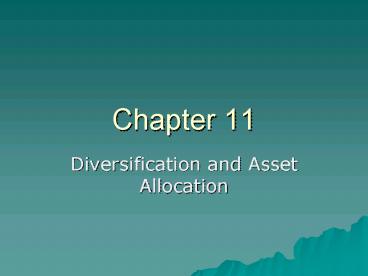Diversification and Asset Allocation - PowerPoint PPT Presentation
1 / 27
Title:
Diversification and Asset Allocation
Description:
Southwest Airlines LUV. AirFrance AKH. JetBlue Airways JBLU. United Airlines UAUA. Avis Budget ... Southwest Airlines. Del Monte Foods. Gauge risk and return ... – PowerPoint PPT presentation
Number of Views:226
Avg rating:3.0/5.0
Title: Diversification and Asset Allocation
1
Chapter 11
- Diversification and Asset Allocation
2
Goals
- To examine the role of diversification and asset
allocation in investing - To assess the risk of individual stocks and
portfolios
3
What is diversification?
- Definition A risk-management technique that
mixes a wide variety of investments within a
portfolio. - Rationale A portfolio of different kinds of
investments will, on average, yield higher
returns and pose a lower risk than any individual
investment found within the portfolio.
4
Types of Risk
- Interest rate risk
- Inflation risk
- Exchange rate risk
- Market risk
- Sovereign risk
- Business risk
- Financial risk
- Liquidity risk
- Political and regulatory risk
Certain types of risk can be diversified away.
5
Diversification and Risk
6
Who is diversifying?
- Nicks portfolio
- Southwest Airlines LUV
- AirFrance AKH
- JetBlue Airways JBLU
- United Airlines UAUA
- Avis Budget Group CAR
- Jens portfolio
- Southwest Airlines LUV
- Del Monte Foods DLM
- Citigroup C
7
Jet Blue vs. United Airlines
Do these stocks move together?
8
Southwest vs. Del Monte
Do these stocks move together?
9
Correlation
- Correlation The tendency of the returns on two
assets to move together. Imperfect correlation is
the key reason why diversification reduces
portfolio risk as measured by the portfolio
standard deviation. - Positively correlated assets tend to move up
and down together. - Negatively correlated assets tend to move in
opposite directions.
10
Correlation
- The correlation coefficient is denoted by
- Corr(RA, RB) or simply, ?A,B.
- The correlation coefficient measures correlation
and ranges from
11
Why Diversification Works
12
Asset Allocation Decision
- How much of your portfolio should you invest in
each asset? - Southwest Airlines
- Del Monte Foods
- Gauge risk and return to make a good decision!
13
Historical vs. Expected Returns
- Historical Average
- Factual stock returns from past periods
- The sum of returns is divided by the number of
observations - Each outcome is equally likely
- Expected Return
- Projected stock returns for future periods
- Average is the sum of weighted possible returns
- Each outcome has a specific probability
14
Asset Allocation with 2 stocks
Calculate the expected rate of return for each
stock.
15
Calculating the Variance of Expected Returns
- The variance of expected returns is calculated as
the sum of the squared deviations of each return
from the expected return, multiplied by the
probability of the state. Here is the formula - The standard deviation is simply the square root
of the variance.
16
Calculating Expected Returns and Variances
17
Portfolios Expected Returns
- The expected return on a portfolio is a linear
combination, or weighted average, of the expected
returns on the assets in that portfolio. - The formula, for n assets, is
- In the formula E(RP) expected portfolio return
- wi portfolio weight in portfolio asset
i - E(Ri) expected return for portfolio asset i
18
Portfolios Expected Returns
- Compute the expected return of a portfolio with
50 LUV and 50 DLM.
19
Variance of Portfolio Expected Returns
- Remember, portfolio variance is generally not a
simple weighted average of the variances of the
assets in the portfolio. - If there are n states, the formula is
- In the formula,
- VAR(RP) variance of portfolio expected return
- ps probability of state of economy, s
- E(Rp,s) expected portfolio return in state s
- E(Rp) portfolio expected return
20
Calculating Variance of Portfolio Expected
Returns
- Note It is possible to construct a portfolio of
risky assets with zero portfolio variance
21
Calculating Portfolio Risk
- For a portfolio of two assets, A and B, the
variance of the return on the portfolio can also
be found by using the correlation
Where wA portfolio weight of asset A
wB portfolio weight of asset B such
that wA wB 1.
The goal is to pick weights which will maximize
returns while minimizing risk.
22
Calculating Portfolio Risk
- LUV DLM E(r) sportfolio
- 10 90 20.5 4.5
- 20 80 21 1
- 30 70 21.5 6.5
- 40 60 22 12
- 50 50 22.5 17.5
- 60 40 23 23
- 70 30 23.5 28.5
- 80 20 24 34
- 90 10 24.5 39.5
23
LUV and DLM
- The standard deviation of the portfolio, sp, was
lower than the weighted average of LUVs and
DLMs s - \ Portfolio provides average return of component
stocks, but lower than average risk. - Why? Negative correlation between stocks.
24
Correlation the Risk-Return Trade-Off
25
Asset Allocation2 Assets with -1lt r lt 0
Anything below this line is inefficient!!!!
26
Correlation and Diversification
- The various weight combinations of risk and
return available all fall on a smooth curve. - This curve is called an investment opportunity
set because it shows the possible combinations of
risk and return available from portfolios of
these two assets. - A portfolio that offers the highest return for
its level of risk is said to be an efficient
portfolio. - The undesirable portfolios are said to be
dominated or inefficient.
27
Quick Quiz
- What is the asset allocation decision?
- What does correlation tell us about returns?
- What is an inefficient portfolio?































